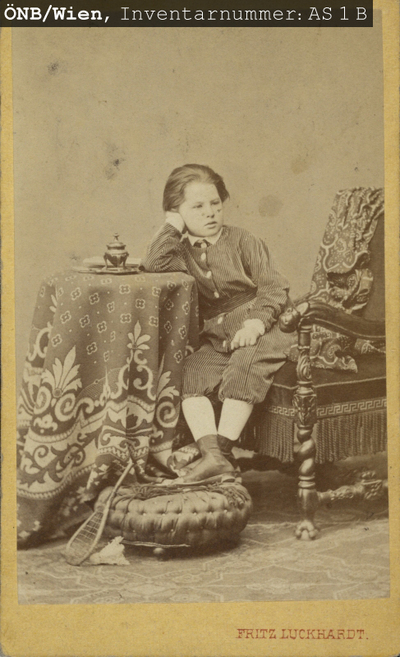Arthur Schnitzler, a Biographical Sketch
by Kristina Fink, translated by Andrew Webber
Family | Childhood, youth and first literary experiments | Schnitzler as doctor | Schnitzler becomes a writer | Schnitzler becomes a father | Old Age
Family ⇑
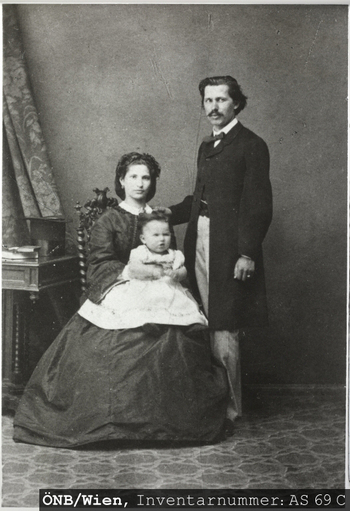
Arthur Schnitzler – the first child of Johann (1835–1893) and Louise Ludovica Schnitzler (1840–1911) – was born on 15 May 1862 at 16 Jägerzeile (which was soon to be renamed Praterstraße) in Leopoldstadt, Vienna’s Second District. His mother was the daughter of the renowned doctor Philip Markbreiter (1810–1892), who came from a family of Viennese Court Jewellers, and Amalia, née Schey von Koromla (1815–1884), Hungarian daughter of a Jewish aristocratic family with baronial title. His father was the son of the carpenter Joseph Zimmermann (1810–1864), later renamed Schnitzler, and his wife Rosalie, née Klein (d. 1868). Johann originally wanted to be a writer, but ultimately decided to study medicine and settled in Vienna as a laryngologist. In the 1870s and 1880s he was first made a University Professor, then a Councillor, and – as one of its founders – Director of the Vienna General Polyclinic. An internationally respected authority on the larynx, he also became editor – in some cases also co-founder – of well-known medical journals like the Wiener Medizinische Presse and the Internationale Klinische Rundschau, with their many supplements.
Two years after the birth of Arthur, his parents had a second child, Joseph Emil, who however only survived for nine weeks.[1] After the family moved to the city centre, the Schottenbastei in the First District, came the birth of Arthur’s brother Julius (1865–1939), who later became Professor of Surgery. And in 1867 there followed a sister, Gisela (d. 1953), later the wife of Marcus Hajek (1861–1941), also Professor of Laryngology.
Childhood, youth and first literary experiments ⇑
Arthur Schnitzler’s initial education was provided by various home tutors. In 1868, the family moved to another location in the First District, 11 Giselastraße (the present-day Bösendorferstraße). Arthur’s father ran his practice from their home address, so that his son already had contact with patients from childhood, most of them stage actors.[2] Berta Lehmann, who was employed as a governess from 1870, encouraged Arthur’s interest in literature and theatre from an early age. Her brother inspired him to write his first drama, Aristocrat and Democrat (Aristokrat und Demokrat).[3] In 1871 the family moved once more to another First District address, an apartment at 1 Burgring, and in autumn of that year Schnitzler was enrolled at the Akademische Gymnasium, the oldest grammar school in Vienna. Besides Arthur and Julius Schnitzler, the school counted such as Franz Schubert, Johann Nepomuk Nestroy, Peter Altenberg, Richard Beer-Hofmann, Hugo von Hofmannsthal and Lise Meitner among its pupils. – Arthur continued to pursue his own literary experiments, as witnessed by the following anecdote: ‘The first poem was inspired by an experience whose content is readily derivable from my verses, so that I am presenting them here as a chronicler and, as will be immediately clear, certainly not out of vanity. They run as follows: ‘Figaro’s marriage is past – Yet the cries of Arthur still they last – For his hat he has lost – Mama’s rage of this the cost – Yet he finds it in the end – And soon he lies at rest in bed.’ It seems understandable that the success of this poem, when I read it out to my Israelite colleagues – alongside another more serious one, with the title ‘Sardanapal’ – left quite something to be desired.’[4]
In the spring of 1875 Arthur, now 13, fell in love for the first time. His love was also reciprocated by Fanny (Fännchen), Franziska Reich, the daughter of his neighbours, but – on account of Fanny’s family moving house and the disapproval of both sets of parents – it had no future.[5] At the age of 15 he sent some of his poems to various newspapers and weeklies for publication, but without success. – After an incidental break of almost two years, Arthur and Fanny met once more in September 1878 and resumed their love affair. On 8 July 1879 Schnitzler passed the school leaving examination.
Schnitzler as doctor ⇑
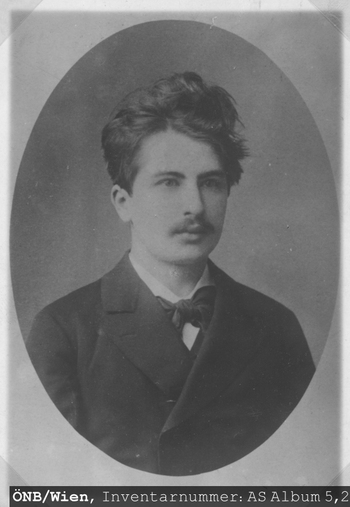 As reward for the successful examination the family spent two weeks in the autumn in Amsterdam, where Arthur accompanied his father to a medical conference. Following his father’s wish, Arthur wrote a travel account which his father published in the Viennese medical journal, Wiener medizinische Presse, under the title ‘From Amsterdam to Ymuiden’. After their return Arthur began his medical studies at the University of Vienna, more out of ‘habit’ than inclination,[6] with the realisation that ‘I feel it already, science will never mean to me what art already does’.[7] Half a year later the 18 year-old weighed up his substantial, though generally still covert literary productivity: ‘I have accordingly completed to the present day 23 dramas and begun writing 13, as far as I can recall.’[8] Schnitzler acquired a position as copy editor for the medical journal, Internationale Klinische Rundschau. With the mediation of a childhood friend, a first poem, the ‘Love Song of the Ballerina’ (‘Liebeslied der Ballerina’) appeared in November in the Munich journal, Der Freie Landbote, along with an essay ‘On Patriotism’. In May 1881, after Arthur – now almost 19 – had given the actor and regular visitor to the family home, Adolf von Sonnenthal, the comedy Out of Fashion (Aus der Mode) to read, his father delivered a letter to him containing Sonnenthal’s withering critique. – However, on the same day, Arthur began a new play, declaring that: ‘A failure shall not deter me’.[9]
As reward for the successful examination the family spent two weeks in the autumn in Amsterdam, where Arthur accompanied his father to a medical conference. Following his father’s wish, Arthur wrote a travel account which his father published in the Viennese medical journal, Wiener medizinische Presse, under the title ‘From Amsterdam to Ymuiden’. After their return Arthur began his medical studies at the University of Vienna, more out of ‘habit’ than inclination,[6] with the realisation that ‘I feel it already, science will never mean to me what art already does’.[7] Half a year later the 18 year-old weighed up his substantial, though generally still covert literary productivity: ‘I have accordingly completed to the present day 23 dramas and begun writing 13, as far as I can recall.’[8] Schnitzler acquired a position as copy editor for the medical journal, Internationale Klinische Rundschau. With the mediation of a childhood friend, a first poem, the ‘Love Song of the Ballerina’ (‘Liebeslied der Ballerina’) appeared in November in the Munich journal, Der Freie Landbote, along with an essay ‘On Patriotism’. In May 1881, after Arthur – now almost 19 – had given the actor and regular visitor to the family home, Adolf von Sonnenthal, the comedy Out of Fashion (Aus der Mode) to read, his father delivered a letter to him containing Sonnenthal’s withering critique. – However, on the same day, Arthur began a new play, declaring that: ‘A failure shall not deter me’.[9]
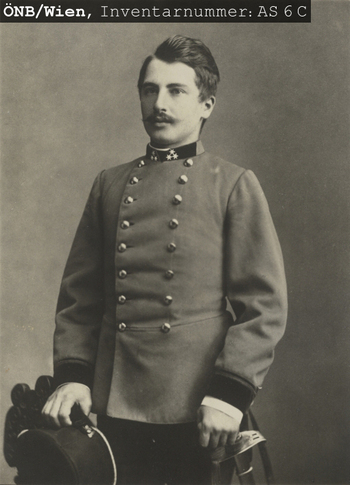 On 25 November 1881, Schnitzler met Gusti, a singer from a theatre chorus living in the suburbs, fell in love and recognised in her the type of the ‘sweet young girl’ (süßes Mädel), which would be an ongoing source of fascination and literary inspiration for him. – At the beginning of October 1882 he joined the Garrison Hospital No. 1 in Vienna as a one-year volunteer (student of military medicine), and one year later he passed the officers’ examination and turned his back on the military. At the end of May 1885 Schnitzler graduated as ‘doctor in general medicine’ and began practical training to become an assistant doctor at the General Hospital and as an aspirant at the Viennese Polyclinic. During this time, he occasionally deputised for his father in his practice.
On 25 November 1881, Schnitzler met Gusti, a singer from a theatre chorus living in the suburbs, fell in love and recognised in her the type of the ‘sweet young girl’ (süßes Mädel), which would be an ongoing source of fascination and literary inspiration for him. – At the beginning of October 1882 he joined the Garrison Hospital No. 1 in Vienna as a one-year volunteer (student of military medicine), and one year later he passed the officers’ examination and turned his back on the military. At the end of May 1885 Schnitzler graduated as ‘doctor in general medicine’ and began practical training to become an assistant doctor at the General Hospital and as an aspirant at the Viennese Polyclinic. During this time, he occasionally deputised for his father in his practice.
In April 1886, when Schnitzler was staying in Merano with suspected tuberculosis, he met Olga Waissnix (1862–1897), the ‘beautiful, worldly, educated woman who kept the Thalhof hotel in Reichenau, not far from Vienna, which was frequented by members of the upper classes’.[10] – Their love remained platonic, as Olga was (albeit unhappily) married, but they became life-long correspondents. – In May of the same year Schnitzler noted in his diary: ‘It was arrant foolishness of mine to become a doctor, and sadly foolishness that cannot be made good. […] oh I want to be free, in short: to be rich and an artist.’[11] But he nevertheless continued his training, first becoming an intern, and regularly published medical articles and reviews in the Internationale Klinische Rundschau, the editorial team of which he had also joined.[12] Beyond this, however, Schnitzler also published poems, prose pieces, sketches and aphorisms on a regular basis.
At the start of September 1887 his relationship with Jeannette Heeger, which was to last around two years, began. Heeger, who lived in the suburbs and carried out sewing work for luxury shops – would be the model for the figure of Cora in the Anatol cycle and before that in the one act play The Adventure of His Life (Das Abenteuer seines Lebens), which he published as a playbook at his own expense in 1888. He undertook study trips to Berlin and London among other places, began a five-year stint as assistant doctor at the Vienna General Polyclinic in the autumn, and published the medical text On Functional Aphonia and Its Treatment Through Hypnosis and Suggestion (1889). Nonetheless, the focus of Schnitzler’s interests gravitated increasingly to creative writing: ‘I am living much as I did before, but have more or less established myself […] Every now and again a patient will appear, like a shooting star […] In my surgery hours I write comedies’.[13]
Schnitzler becomes a writer ⇑
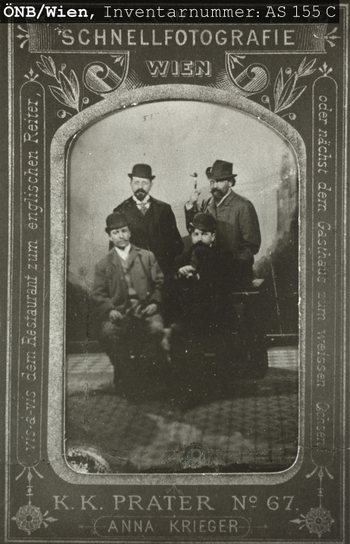 In May 1889 Schnitzler began a relationship with Marie ‘Mizi’ Chlum (1867–1925), an actress whose stage name was Glümer and who once more embodied for him ‘the ideal of the “sweet young girl”’.[14] In particular, Schnitzler’s retrospective jealousy with regard to Mizi’s previous lovers flowed into his first major piece for the stage, The Fairytale (Das Märchen),[15] in the form of Fedor Denner’s jealousy over past admirers of Fanny Theren. In the same year Schnitzler also for the first time published more substantial literary works: America (Amerika), The Other Man (Der Andere), My Friend Y (Mein Freund Ypsilon), Episode and various poems. In Café Griensteidl, where a circle of young writers, soon to be known as ‘Jung Wien’ (‘Young Vienna’), had gathered since around 1890, he got to know among others the young Hugo von Hofmannsthal as well as others of his own generation: Felix Salten, Richard Beer-Hofmann and Hermann Bahr. In 1890, alongside several medical reviews, Schnitzler also published Alkandi’s Song (Alkandis Lied), The Question for Destiny (Die Frage an das Schicksal) and The Morning of Anatol’s Wedding (Anatols Hochzeitsmorgen), and was able to note in the February of the following year: ‘literary recognition is beginning’.[16] In April came the first performance of one of his plays – in the shape of The Adventure of His Life – and in October he noted with pride: ,For Loris [=Hofmannthal], Salten, Beer-Hofmann and I are already being viewed as a clique.’[17] In the autumn of the same year the ideas developed for Fair Game (Freiwild), Family (Familie) and The Poor Young Girl (Das arme Mädel, later known as Liebelei (Dalliance)), while poems by Schnitzler were recited by the actor Max Devrient as part of a performance staged by the Freie Bühne (Free Stage), and he published The Fairy-tale (as a playbook) as well as Memorial Stones (Denksteine), Wealth (Reichtum), Christmas Shopping (Weihnachtseinkäufe) and aphorisms. Bonds of life-long friendship developed between Schnitzler and several of the writers of ‘Jung Wien’, even if he soon turned away from the café and the group as such: ‘Can’t bear Griensteidl; the atmosphere […] depresses me’.[18] Schnitzler remained productive meanwhile, going on to publish The Son (Der Sohn) and Anatol.
In May 1889 Schnitzler began a relationship with Marie ‘Mizi’ Chlum (1867–1925), an actress whose stage name was Glümer and who once more embodied for him ‘the ideal of the “sweet young girl”’.[14] In particular, Schnitzler’s retrospective jealousy with regard to Mizi’s previous lovers flowed into his first major piece for the stage, The Fairytale (Das Märchen),[15] in the form of Fedor Denner’s jealousy over past admirers of Fanny Theren. In the same year Schnitzler also for the first time published more substantial literary works: America (Amerika), The Other Man (Der Andere), My Friend Y (Mein Freund Ypsilon), Episode and various poems. In Café Griensteidl, where a circle of young writers, soon to be known as ‘Jung Wien’ (‘Young Vienna’), had gathered since around 1890, he got to know among others the young Hugo von Hofmannsthal as well as others of his own generation: Felix Salten, Richard Beer-Hofmann and Hermann Bahr. In 1890, alongside several medical reviews, Schnitzler also published Alkandi’s Song (Alkandis Lied), The Question for Destiny (Die Frage an das Schicksal) and The Morning of Anatol’s Wedding (Anatols Hochzeitsmorgen), and was able to note in the February of the following year: ‘literary recognition is beginning’.[16] In April came the first performance of one of his plays – in the shape of The Adventure of His Life – and in October he noted with pride: ,For Loris [=Hofmannthal], Salten, Beer-Hofmann and I are already being viewed as a clique.’[17] In the autumn of the same year the ideas developed for Fair Game (Freiwild), Family (Familie) and The Poor Young Girl (Das arme Mädel, later known as Liebelei (Dalliance)), while poems by Schnitzler were recited by the actor Max Devrient as part of a performance staged by the Freie Bühne (Free Stage), and he published The Fairy-tale (as a playbook) as well as Memorial Stones (Denksteine), Wealth (Reichtum), Christmas Shopping (Weihnachtseinkäufe) and aphorisms. Bonds of life-long friendship developed between Schnitzler and several of the writers of ‘Jung Wien’, even if he soon turned away from the café and the group as such: ‘Can’t bear Griensteidl; the atmosphere […] depresses me’.[18] Schnitzler remained productive meanwhile, going on to publish The Son (Der Sohn) and Anatol.
1893 was a hard year for Schnitzler. In the March of that year Mizi Glümer’s confession of infidelity left him in a fury, even if he had been unfaithful to her on multiple occasions: ‘I berate and hit her’.[19] – The conflicts with Mizi also found their way into The Fairy-tale.[20] At the end of April Schnitzler’s father developed erysipelas in his face and died on 2 May after blood poisoning. – In August Schnitzler left the Polyclinic and from then on only saw a limited number of patients in private practice. He also moved in with his mother at her Frankgasse address.
At the beginning of December 1893 The Fairy-tale was given its premiere at the Deutsches Volkstheater in Vienna, with Adele Sandrock as Fanny Theren – a production which prompted a theatre scandal and was curtailed after only two performances. However, the diva Sandrock began an exalted affair with Schnitzler. Then, in the summer of 1894 the singing teacher Marie ‘Mizi’ Reinhard (1871–1899) was treated by Schnitzler, and they fell in love, making plans for a future together. He sold the Internationale Klinische Rundschau journal, struck up lifelong friendships with Otto Brahm and Georg Brandes, and published Flowers (Blumen), The Three Elixirs (Die drei Elixire), Dying (Sterben), The Widower (Der Witwer) and The Fairy-tale. When, in 1895, Adele Sandrock was unfaithful with his friend Felix Salten, Schnitzler ended the relationship and was ‘nothing short of grateful to him’.[21] Since April of that year Schnitzler had been conducting double relationships with Mizi Glümer and Mizi Reinhard. – That autumn his success as a writer reached a new level when he entered into a general contract for the publication of his works. The S. Fischer publishing house in Berlin was establishing itself at that time as the most significant press for contemporary literature, so that a general contract of this kind represented at once a great opportunity and a mark of distinction for an author.[22] In the same year Dalliance also premiered at the Burgtheater in Vienna with a star cast (Adele Sandrock, Friedrich Mitterwurzer and Adolf von Sonnenthal), which amounted to Schnitzler’s ‘artistic breakthrough’.[23] In addition, Dying and The Little Comedy (Die kleine Komödie) appeared.
In the summer of 1896 Schnitzler made a trip to Scandinavia, which took him, among other places, to the North Cape, to Christiania (visiting Henrik Ibsen) and to Copenhagen (where he met with Georg Brandes and Peter Nansen).
In the autumn came another fateful setback: Schnitzler now suffered (much like Beethoven) from otosclerosis, which left him increasingly hard of hearing and plagued by loud noises in the ear and would become ever more of a burden for the rest of his life.[24] His condition repeatedly drove him to the verge of desperation, spoiled many a social gathering, concert or theatre visit, would keep him awake all night, and frequently brought him to tears.
Schnitzler had in the meantime published Dalliance, A Farewell (Ein Abschied) and The Overstrung Person (Die überspannte Person), when Marie Reinhard realised in January 1897 that she was pregnant. As nobody was to know of this in Vienna, she left the city in order to bring the child into the world elsewhere. During this time Mizi Glümer once more appeared in Schnitzler’s life, and the covert double relationship was resumed. Schnitzler also had other affairs alongside this and was fearful of his role as father.[25] When Mizi Reinhard had a still-birth Schnitzler was shattered and noted the ‘deep feeling of a connection between the death of the child and my lack of interest for the child before the birth’.[26] – In 1897 and 1898 he published The Wise Man’s Wife (Die Frau des Weisen), The Day of Glory (Der Ehrentag), Half-past One (Halbzwei), The Dead are Silent (Die Toten schweigen), Fair Game and Paracelsus.
On 18 March 1899 Marie Reinhard died in Schnitzler’s presence, suddenly and in full consciousness from a sepsis following a burst appendix. Schnitzler was close to a nervous breakdown and interrupted the entries in his diary for several months. Four days after her death, he described the feeling of loss as a ‘loneliness without compare – I have to think of how I have always tried to depict people who lose what is dearest to them – for there is something that cannot be expressed – just like eternity, infinity: – loneliness, having been made lonely; being made to be lonely.’[27] Schnitzler would hold the anniversary of Marie Reinhard’s death in remembrance until the end of his life.
At the end of March 1899 Schnitzler was awarded the Bauernfeld Prize for his novellas and dramatic works. That spring came the first encounter with the drama student twenty years his junior, Dina Marius, alias Olga Gussmann (1882–1970), a great admirer of the author.[28] Schnitzler published Around an Hour (Um eine Stunde), The Legacy (Das Vermächtnis), The Green Cockatoo (Das grüne Kakadu) and The Female Companion (Die Gefährtin). In the summer of the following year he wrote Lieutenant Gustl and noted down the ‘feeling that it is a masterpiece’;[29] this, a judgement that would be endorsed by the success of the monologue novella. On stage, on the other hand, he experienced a slump. After quarrelling with Paul Schlenther on account of the rejection of The Veil of Beatrice (Der Schleier der Beatrice) – in spite of the protestations of well-known friends and fellow-writers – there followed a five-year exclusion of his plays from the Vienna Burgtheater. Schnitzler published a private edition of Round Dance (Reigen), Blind Geronimo and His Brother (Der blinde Geronimo und sein Bruder) and Lieutenant Gustl. – Olga Gussmann meanwhile discovered that she was expecting a child by Schnitzler. After serious complications, however, the pregnancy had to be terminated: ‘The dream is over. – I was there for almost the whole day […]. She had to have surgery and suffered greatly’.[30]
As a consequence of the publication of Lieutenant Gustl Schnitzler was stripped in absentia of the rank of officer.[31] In the course of the year he also published Frau Bertha Garlan, Lively Hours (Lebendige Stunden), New Year’s Eve (Sylvesternacht) and The Veil of Beatrice.
Schnitzler becomes a father ⇑
In January 1902 Olga Gussmann turned twenty, was pregnant once more and wished to be married to Schnitzler. As in the case of Marie Reinhard, Schnitzler was evasive and searched for a small house outside Vienna where Olga could give birth in the summer. On 9 August she brought Heinrich Schnitzler (d. 1982) into the world in Hinterbrühl. Schnitzler made a lapidary note: ‘At 4 the boy comes into the world. – […] At 5 began the novel’.[32] During this year Schnitzler published The Stranger (Die Fremde), Andreas Thameyer’s Last Letter (Andreas Thameyers letzter Brief), The Greek Dancer (Die griechische Tänzerin), Excentric, The Woman with the Dagger (Die Frau mit dem Dolche), The Last Masks (Die letzten Masken) and Literature (Literatur). March 1903 saw the second award of the Bauernfeld Prize, this time for the cycle Lively Hours. On 26 August Arthur and Olga Schnitzler were married at the synagogue in the Schopenhauergasse, accompanied by their witnesses Richard Beer-Hofmann and Gustav Schwarzkopf. Shortly after the wedding the 42-year-old Schnitzler moved away from his mother and into an apartment in the Spöttelgasse with Olga and Heinrich, so setting up house for the first time – if one disregards the ‘love nest’ in Tuchlauben that he rented from December 1899 for two months during his relationship with ‘P.M.’ (i.e. Leopoldine Müller).[33] During the course of the year, he published The Puppeteer (Der Puppenspieler), The Green Necktie (Die grüne Kravatte) and Round Dance.
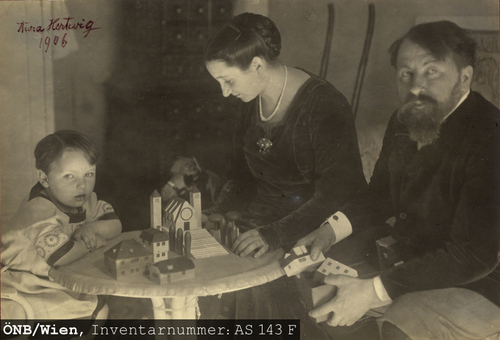 In March 1904, the edition of Round Dance that had appeared the year before was banned in Germany. At the beginning of July, Theodor Herzl died, and Schnitzler was deeply shaken by the news.[34] The ensuing years saw less commotion, apart from many trips and premieres, but they were all the more productive for this. Schnitzler published Gallant Cassian (Der tapfere Cassian), The Fate of Baron von Leisenbohg (Das Schicksal des Freiherrn von Leisenbohg), The Lonely Way (Der einsame Weg), The New Song (Das neue Lied), At the Big Puppet Show (Zum großen Wurstel), The Prophecy (Die Weissagung), Blind Geronimo and His Brother, Andreas Thameyer’s Last Letter, The Stranger, The Call of Life (Der Ruf des Lebens), Marionettes (Marionetten), Three One Act Plays (Drei Einakter), Story of a Genius (Geschichte eines Genies), Dead Gabriel (Der tote Gabriel), The Prophecy, The New Song and Intermezzo (Zwischenspiel). For the last of these he was awarded the Grillparzer Prize on 15 January 1908. In May of that year he made the acquaintance of Stefan Zweig and in November Thomas Mann, and soon began to exchange friendly letters with them. He published Countess Mizzi or The Family Day (Komtesse Mizzi oder Der Familientag), The Death of the Bachelor (Der Tod des Junggesellen), The Transformations of Pierrot (Die Verwandlungen des Pierrot) and The Path into the Open (Der Weg ins Freie).
In March 1904, the edition of Round Dance that had appeared the year before was banned in Germany. At the beginning of July, Theodor Herzl died, and Schnitzler was deeply shaken by the news.[34] The ensuing years saw less commotion, apart from many trips and premieres, but they were all the more productive for this. Schnitzler published Gallant Cassian (Der tapfere Cassian), The Fate of Baron von Leisenbohg (Das Schicksal des Freiherrn von Leisenbohg), The Lonely Way (Der einsame Weg), The New Song (Das neue Lied), At the Big Puppet Show (Zum großen Wurstel), The Prophecy (Die Weissagung), Blind Geronimo and His Brother, Andreas Thameyer’s Last Letter, The Stranger, The Call of Life (Der Ruf des Lebens), Marionettes (Marionetten), Three One Act Plays (Drei Einakter), Story of a Genius (Geschichte eines Genies), Dead Gabriel (Der tote Gabriel), The Prophecy, The New Song and Intermezzo (Zwischenspiel). For the last of these he was awarded the Grillparzer Prize on 15 January 1908. In May of that year he made the acquaintance of Stefan Zweig and in November Thomas Mann, and soon began to exchange friendly letters with them. He published Countess Mizzi or The Family Day (Komtesse Mizzi oder Der Familientag), The Death of the Bachelor (Der Tod des Junggesellen), The Transformations of Pierrot (Die Verwandlungen des Pierrot) and The Path into the Open (Der Weg ins Freie).
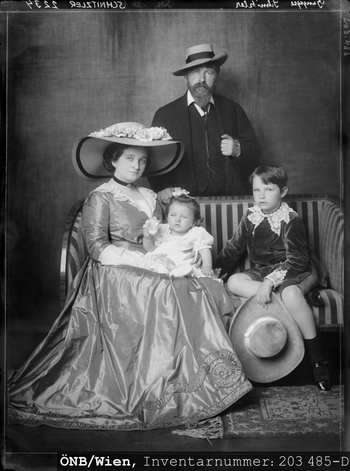 On 13 September 1909 Olga brought their daughter Lili into the world (d. 1928), and ten days later Frieda Pollak took on a steady engagement as Schnitzler’s secretary. Gallant Kassian (Der tapfere Kassian) appeared as a Singspiel. On 7 April 1910 Schnitzler bought the house at 71 Sternwartestraße (in Währing, Vienna’s 18th District) for the family of four, and they moved in in the middle of July. Also in April he made the acquaintance of Heinrich Mann. And in the same year he published The Young Medardus (Der junge Medardus) and The Veil of Pierrette (Der Schleier der Pierrette). Olga Schnitzler, who had in the meantime abandoned her dreams of an acting career, kept working towards a breakthrough as a singer. In February 1911 she gave her first public concert, but the success she had hoped for eluded her for the rest of her life. In May of the same year, the composer Gustav Mahler, whom Schnitzler admired greatly, died. And in July Schnitzler’s mother contracted periostitis and died on 9 September at the age of 71. – Meanwhile, Schnitzler published The Threefold Warning (Die dreifache Warnung), The Murderer (Der Mörder), The Shepherd’s Flute (Die Hirtenflöte), Redegonda’s Diary (Das Tagebuch der Redegonda) and The Wide Domain (Das weite Land).
On 13 September 1909 Olga brought their daughter Lili into the world (d. 1928), and ten days later Frieda Pollak took on a steady engagement as Schnitzler’s secretary. Gallant Kassian (Der tapfere Kassian) appeared as a Singspiel. On 7 April 1910 Schnitzler bought the house at 71 Sternwartestraße (in Währing, Vienna’s 18th District) for the family of four, and they moved in in the middle of July. Also in April he made the acquaintance of Heinrich Mann. And in the same year he published The Young Medardus (Der junge Medardus) and The Veil of Pierrette (Der Schleier der Pierrette). Olga Schnitzler, who had in the meantime abandoned her dreams of an acting career, kept working towards a breakthrough as a singer. In February 1911 she gave her first public concert, but the success she had hoped for eluded her for the rest of her life. In May of the same year, the composer Gustav Mahler, whom Schnitzler admired greatly, died. And in July Schnitzler’s mother contracted periostitis and died on 9 September at the age of 71. – Meanwhile, Schnitzler published The Threefold Warning (Die dreifache Warnung), The Murderer (Der Mörder), The Shepherd’s Flute (Die Hirtenflöte), Redegonda’s Diary (Das Tagebuch der Redegonda) and The Wide Domain (Das weite Land).
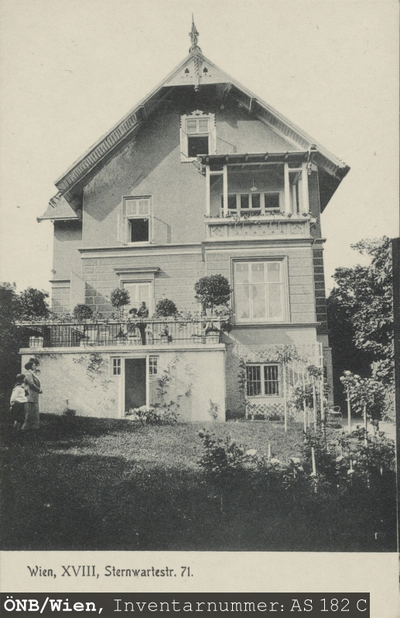 On 15 May 1912, to mark his fiftieth birthday, there were 26 performances of Schnitzler’s dramas, in his absence, in German-speaking theatres, and Fischer published the first edition of his collected works, in seven volumes. At the same time, the political situation was becoming increasingly tense, and several of Schnitzler’s dramas fell victim to the respective censorship offices. In October, for example, the premiere of Round Dance in Budapest was forbidden by police order, and a performance of Professor Bernhardi in Vienna was refused by the censors, with the premiere taking place instead at the Kleines Theater in Berlin on 28 November. On that same evening, Schnitzler’s friend of many years, Otto Brahm, died. In the course of 1912, Professor Bernhardi was published, along with The Shepherd’s Flute, The Death of the Bachelor, The Murderer, The Dead Gabriel (Der tote Gabriel), Redegonda’s Diary, and The Threefold Warning.
On 15 May 1912, to mark his fiftieth birthday, there were 26 performances of Schnitzler’s dramas, in his absence, in German-speaking theatres, and Fischer published the first edition of his collected works, in seven volumes. At the same time, the political situation was becoming increasingly tense, and several of Schnitzler’s dramas fell victim to the respective censorship offices. In October, for example, the premiere of Round Dance in Budapest was forbidden by police order, and a performance of Professor Bernhardi in Vienna was refused by the censors, with the premiere taking place instead at the Kleines Theater in Berlin on 28 November. On that same evening, Schnitzler’s friend of many years, Otto Brahm, died. In the course of 1912, Professor Bernhardi was published, along with The Shepherd’s Flute, The Death of the Bachelor, The Murderer, The Dead Gabriel (Der tote Gabriel), Redegonda’s Diary, and The Threefold Warning.
Olga’s dissatisfaction, along with differences of opinion about her career plans, led ever more frequently to heated disagreements between husband and wife, and in spring 1913 there was talk of separation. That December, Theodor Reik, a disciple of Freud’s, published his study, ‘Arthur Schnitzler als Psycholog’ (‘Arthur Schnitzler as Psychologist’), about which Schnitzler then wrote to him: ‘I read [it] with genuinely strong interest, not infrequently in substantive agreement, though of course not without lively objection […] [W]here you remain within the bounds of the conscious mind, I am frequently able to accompany you. But as for my unconscious, or let us say my half-conscious –, I know more still than you […]’.[35] In the course of the year Frau Beate and Her Son (Frau Beate und ihr Sohn) appeared. And, with a tally of 200 performances, Schnitzler was now ‘the most performed author’ at the Burgtheater.[36]
In January 1914 the premiere of Elskoveg, the first (silent) film to be adapted from a work of Schnitzler’s (Dalliance), took place in Copenhagen. In March of the same year, he was awarded the Raimund Prize for The Young Medardus. He spent the summer months in Switzerland, and news of the outbreak of the First World War reached him there: ‘At the hotel news of England’s declaration of war against Germany! – World War. World ruin. Enormous and enormously awful news. – […] We are experiencing a moment of enormity in world history. In a few days the picture of the world has utterly changed. One thinks one’s dreaming. People are all at a loss.–’[37] In the course of 1914 Schnitzler published The Dead Are Silent, The Prophecy, and The New Song. In May 1915 he started work on his autobiography. It was to be called Life and Resonance – Work and Echo (Leben und Nachklang – Werk und Widerhall) and in the event was published posthumously as a fragment in 1968, with the title Youth in Vienna (Jugend in Wien). Also in 1915, he published Comedy of Words: Three One Act Plays (Komödie der Worte: Drei Einakter).
In March 1916 Schnitzler received a visit from the now widowed friend from his youth and mother of two children Clara Katharina Pollaczek (née Loeb). – At the beginning of 1917 Olga experienced a profound life crisis and blamed her failed career on her husband, the children and the ‘Schnitzler’ name. On Schnitzler’s 55th birthday, a young nurse and friend of the family, Stephi Bachrach, poisoned herself, causing him great shock; he would later weave some details of this tragic event into the motifs of Fräulein Else.[38] In the course of the year, he published Dr Gräsler, Spa Physician (Doktor Gräsler, Badearzt) and his only comedy in more than one act, Fink and Fliederbusch (literally, ‘Finch and Lilacbush’). In the summer of the following year Schnitzler finished his autobiography. At the beginning of November, Kaiser Wilhelm II abdicated and fled to the Netherlands, while the foundation of the Weimar Republic was declared in Germany. In Vienna, Emperor Karl I resigned, and the provisional National Assembly also declared a Republic. Schnitzler commented: ‘A day of world historical proportions is over. From close up it is not all that impressive.– ’[39] 1918 also saw the publication of Casanova’s Journey Home (Casanovas Heimfahrt).
The summer of 1919 brought Schnitzler’s first meeting with Hedy Kempny, the ‘free, emancipated and self-confident woman of a new epoch’,[40] with whom he soon developed a close, platonic relationship. He also got to know Vilma Lichtenstern. In the meantime, the marriage crisis in the Schnitzler household led to a mutual desire for separation. Schnitzler published The Sisters or Casanova in Spa (Die Schwestern oder Casanova in Spa). In March he reworked first The Young Medardus and then The Call of Life into film scripts. In April he fell when out walking and suffered an injury to his shoulder joint that would plague him with pain until the end of his life. In the winter, the marriage crisis reached a new climax. Olga confessed an affair to her husband; and though Schnitzler had maintained a principle of fidelity throughout their marriage, she accused him of affairs with Hedy Kempny and Vilma Lichtenstern. The arguments escalated and she left to stay with a female friend in Munich. On 23 December, the premiere of Round Dance (banned up to that point) was able to take place in the Kleines Schauspielhaus theatre in Berlin. Olga had returned meanwhile, in order to spend the festive season with her family. She had decided upon a divorce and planned to leave Vienna.
In February 1921, after anti-Semitic rioting during a Viennese production of Round Dance, further performances were forbidden, and a Berlin production also ended with 34 arrests. In March Schnitzler instigated proceedings for imminent divorce, in accordance with Olga’s wishes, and also had alterations made to his will. Lili Schnitzler had in the meantime developed problems at school and was given extra tuition by Anna Freud, daughter of the famous psychoanalyst. Schnitzler accompanied his daughter to 19 Berggasse and had the opportunity to speak briefly with Sigmund Freud and his wife. On 26 June, the divorce was concluded, after 18 years of married life. The 12-year-old Lili stayed with her father, while Heinrich – no longer a minor – went his own way: after having to give up a career as a pianist on account of tendonitis he opted for the theatre instead. In September the public prosecutor pressed charges against the management, director and actors of the Round Dance production at the Kleines Schauspielhaus in Berlin – the trial ending with the all the accused being found not guilty.[41]
To mark Schnitzler’s sixtieth birthday Fischer extended the collected works edition by one further volume per section. In June 1922, prompted by a very open letter of 14 May sent by Freud as a birthday greeting and suggesting that he had hitherto avoided the author ‘out of a kind of Doppelgänger fear’,[42] they had dinner together in Freud’s home and so their first more lengthy meeting. Freud then accompanied Schnitzler back to the Sternwartestraße, and the conversation became warmer and more personal. There followed other meetings, before the contact fell dormant. – In November, when Schnitzler was on a trip giving readings in Czechoslovakia, the planned event in Teplitz was interrupted because ‘the good swastika-bearers burst my reading apart’.[43] The right-wing extremists also kept watch for Schnitzler in the streets, and it was only by good fortune that he was able to escape. Schnitzler described anti-Semitism in cynical style as ‘the most brilliant notion that human baseness has ever had’.[44]
In the meantime, Olga repeatedly expressed the desire to move back into the Sternwartestraße, but Schnitzler firmly declined. In January of the following year Olga informed him that she had decided to buy a villa in Baden-Baden and to settle there. The realisation of the definitive character of the separation that this decision brought with it pained Schnitzler, who was convinced that he would never again love a woman after Olga, and at the same time developed a ‘relationship that was more erotic than tender’ with Clara Katharina Pollaczek.[45] – In the spring of 1923 Schnitzler went on a trip to give readings which took him, among other destinations, to Stockholm. When he arrived at the station he was captured on film for the first and only time in footage lasting barely 30 seconds.[46] In October the silent film The Young Medardus, directed by Michael Kertész, had its premiere in Vienna. In July 1923 Schnitzler was also made an honorary member of the Viennese Academy of Fine Arts and in December named Honorary President of the PEN Club.
In 1924 Schnitzler made the personal acquaintance of Robert Musil and Jean Giraudoux, among others. He published Comedy of Seduction (Komödie der Verführung), Fräulein Else, and the novella collection The Threefold Warning with the Reclam publishing house. He then spent much of the next year travelling, in particular to Baden-Baden (Olga), Berlin (Heinrich) and Italy (with Lili and Olga). Olga had meanwhile decided to move to Berlin. – In mid-November Schnitzler learned of the death of Mizi Glümer, who had poisoned herself. He published The Judge’s Wife (Die Frau des Richters) and Dream Novella (Traumnovelle).
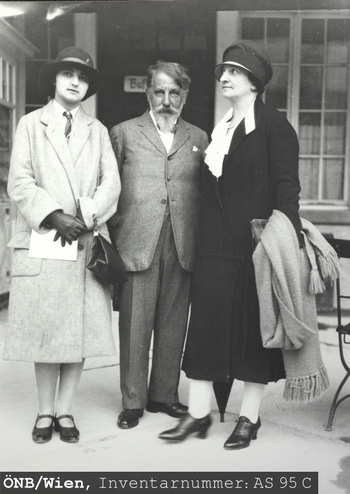 In March 1926 he visited Sigmund Freud, who was suffering from heart problems, and that spring he went on a cruise with Lili, before being presented with the Burgtheater Ring, awarded by the Concordia society of journalists and writers. Olga and Lili spent more time in Venice, where Lili met the man who would later become her husband, the fascist Arnoldo Cappellini, and gave her father effusively enthusiastic reports of him after she returned to Vienna. After a reluctant Schnitzler finally yielded to their insistence, mother and daughter travelled back to Arnoldo in Venice and took up quarters in Alma Mahler’s house. As the year ended, Schnitzler once more met up with Sigmund Freud. In the course of the year he had published The Walk to the Pond (Der Gang zum Weiher) and Game at Dawn (Spiel im Morgengrauen).
In March 1926 he visited Sigmund Freud, who was suffering from heart problems, and that spring he went on a cruise with Lili, before being presented with the Burgtheater Ring, awarded by the Concordia society of journalists and writers. Olga and Lili spent more time in Venice, where Lili met the man who would later become her husband, the fascist Arnoldo Cappellini, and gave her father effusively enthusiastic reports of him after she returned to Vienna. After a reluctant Schnitzler finally yielded to their insistence, mother and daughter travelled back to Arnoldo in Venice and took up quarters in Alma Mahler’s house. As the year ended, Schnitzler once more met up with Sigmund Freud. In the course of the year he had published The Walk to the Pond (Der Gang zum Weiher) and Game at Dawn (Spiel im Morgengrauen).
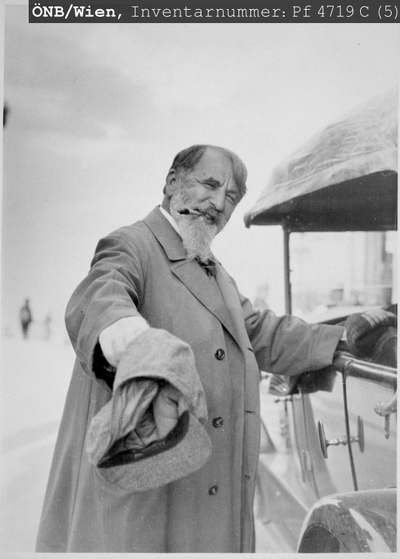 In 1927 Arnoldo officially asked for Lili’s hand in marriage. Schnitzler was concerned: the idea of imminent separation from Lili was unwelcome to him, and he was also plagued by quite substantial financial worries, which would only be exacerbated by the wedding to the penniless Arnoldo. However, when Arnoldo stayed as a guest in Schnitzler’s house in March, he came to like the thirty-eight-year-old: ‘We had an excellent understanding, and I very much liked his free and altogether unaffected nature; without vanity. He is not as ‘radiant’ as O. and Lili had seen him; but has about him the glow of a noble soul’.[47] At the end of April Schnitzler travelled with Lili to Venice. They were successful in their shared search for an apartment: ‘and so I rented it for Lili and Arnoldo – with the feeling that I was doing quite the right thing’.[48]
In 1927 Arnoldo officially asked for Lili’s hand in marriage. Schnitzler was concerned: the idea of imminent separation from Lili was unwelcome to him, and he was also plagued by quite substantial financial worries, which would only be exacerbated by the wedding to the penniless Arnoldo. However, when Arnoldo stayed as a guest in Schnitzler’s house in March, he came to like the thirty-eight-year-old: ‘We had an excellent understanding, and I very much liked his free and altogether unaffected nature; without vanity. He is not as ‘radiant’ as O. and Lili had seen him; but has about him the glow of a noble soul’.[47] At the end of April Schnitzler travelled with Lili to Venice. They were successful in their shared search for an apartment: ‘and so I rented it for Lili and Arnoldo – with the feeling that I was doing quite the right thing’.[48]
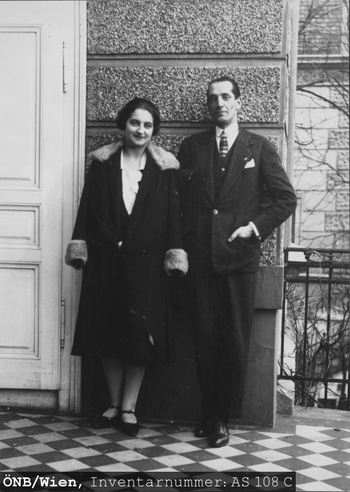 On 5 June Schnitzler heard news of the death of Vilma Lichtenstern in a car crash caused by a risky overtaking manoeuvre by her husband. He was intensely preoccupied with the details of how the accident unfolded and was unable for months to come to terms with the loss. – On 30 June the wedding of Lili and Arnoldo took place in the Vienna Town Hall. The simple ‘ceremony without any celebration’ was followed by a meal in the Sternwartestraße.[49] The couple left for Venice the same evening and Arnoldo consoled Schnitzler on their departure with the words ‘Don’t be sad … She’s in good hands’.[50]
On 5 June Schnitzler heard news of the death of Vilma Lichtenstern in a car crash caused by a risky overtaking manoeuvre by her husband. He was intensely preoccupied with the details of how the accident unfolded and was unable for months to come to terms with the loss. – On 30 June the wedding of Lili and Arnoldo took place in the Vienna Town Hall. The simple ‘ceremony without any celebration’ was followed by a meal in the Sternwartestraße.[49] The couple left for Venice the same evening and Arnoldo consoled Schnitzler on their departure with the words ‘Don’t be sad … She’s in good hands’.[50]
In the meantime, the political situation in Vienna was coming to a head, and there was an atmosphere of revolution in the city. In the course of the ‘July Revolt’ the Palace of Justice was set on fire and there were 90 deaths and 1000 casualties. Schnitzler was only conscious of the worrying events from the margins. He spent the summer of 1927 in South Tyrol, first in the company of Olga and Heinrich and then with Clara, before travelling on to Lili and Arnoldo in Venice, and stepping onto an aeroplane for the first time for the return trip: ‘Departed at 1.45 with the most beautiful weather […] Glorious, feeling of security. […] The strangest thing: how empty of humans the world is, as nobody can be seen on the streets and in the settlements from this height. Incomparable flight over the clouds, as though on a fluffy ocean’.[51] He published Game at Dawn, The Book of Sayings and Second Thoughts (Buch der Sprüche und Bedenken) and The Mind in Words and the Mind in Actions (Der Geist im Wort und der Geist in der Tat). In the spring of 1928 the silent film Fair Game, directed by Holger Madsen, had its premiere in Berlin. Schnitzler’s financial situation was meanwhile ever more under pressure, as he was now maintaining not only his own household but those of Olga in Berlin and Lili in Venice, along with monthly payments to Heinrich. In April he nonetheless undertook a cruise with the young couple and enjoyed it greatly. In the summer Lili and Arnoldo wrote that their financial means were exhausted and that they now planned a career in film. Schnitzler found the idea ‘quite ridiculous’.[52] On 26 July a telegram from Arnoldo reached Schnitzler in Vienna, reporting that Lili was ill and wanted him away from her. Gustav Mahler’s daughter Anna, who was also in Venice, sent a telegraph to Olga three hours later, and on the following day the worried parents flew there only to learn from their 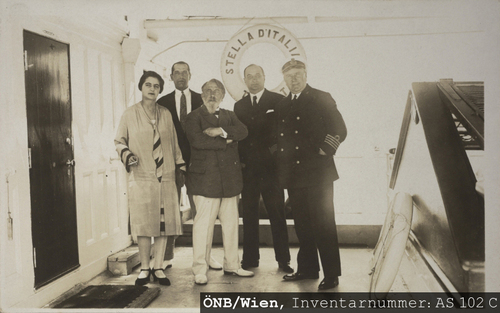 son-in-law that their 18-year-old daughter had shot herself. While Olga went to the hospital to see Lili for a final time, Schnitzler – who could not find the strength to do this – let Arnoldo tell him details of the events, which he then relayed in a letter of 28 July to Clara: ‘after a thoroughly insubstantial exchange of words, which was also been resolved – they were now, at 9 in the evening, set to go for a walk together […] she withdraws for a few moments to the bathroom – a shot; - she has shot herself in the heart with Arnoldo’s pistol. But there was more; – at first the wound did not appear serious; she was convinced she would recover; – hospital, 6 in the morning (on the 26th) operation; afternoon worsening, high fever, other symptoms; – at 10.15 in the evening death. – (While I was in my room holding her picture in my hands and kissing it.) – […] This time the pathological side of her nature sadly emerged in a way that was not to be remedied –; – just a minute later it would not have happened’.[53] – On 29 July Lili was buried in Venice. Schnitzler, Olga, Heinrich and Arnoldo then returned to Vienna. Schnitzler began to read Lili’s diary, which she had kept since the age of 14, and dictated it to Frieda Pollak, for Olga, Heinrich and himself. He would not come to terms with the loss of his beloved daughter for the rest of his life.
son-in-law that their 18-year-old daughter had shot herself. While Olga went to the hospital to see Lili for a final time, Schnitzler – who could not find the strength to do this – let Arnoldo tell him details of the events, which he then relayed in a letter of 28 July to Clara: ‘after a thoroughly insubstantial exchange of words, which was also been resolved – they were now, at 9 in the evening, set to go for a walk together […] she withdraws for a few moments to the bathroom – a shot; - she has shot herself in the heart with Arnoldo’s pistol. But there was more; – at first the wound did not appear serious; she was convinced she would recover; – hospital, 6 in the morning (on the 26th) operation; afternoon worsening, high fever, other symptoms; – at 10.15 in the evening death. – (While I was in my room holding her picture in my hands and kissing it.) – […] This time the pathological side of her nature sadly emerged in a way that was not to be remedied –; – just a minute later it would not have happened’.[53] – On 29 July Lili was buried in Venice. Schnitzler, Olga, Heinrich and Arnoldo then returned to Vienna. Schnitzler began to read Lili’s diary, which she had kept since the age of 14, and dictated it to Frieda Pollak, for Olga, Heinrich and himself. He would not come to terms with the loss of his beloved daughter for the rest of his life.
Old Age ⇑
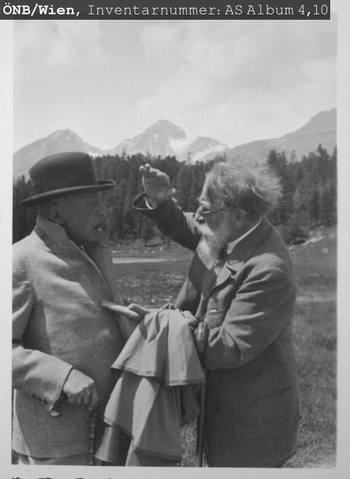 In November 1928 Suzanne Clauser, who would translate Schnitzler’s works into French, under the pseudonym ‘Dominique Auclères’, visited him in the Sternwartestraße. Fischer also supplemented the Narrative Writings section of the Collected Works with two additional volumes, including – among other things – the first edition of Therese: Chronicle of a Woman’s Life (Therese. Chronik eines Frauenlebens).
In November 1928 Suzanne Clauser, who would translate Schnitzler’s works into French, under the pseudonym ‘Dominique Auclères’, visited him in the Sternwartestraße. Fischer also supplemented the Narrative Writings section of the Collected Works with two additional volumes, including – among other things – the first edition of Therese: Chronicle of a Woman’s Life (Therese. Chronik eines Frauenlebens).
On 27 March 1929 the premiere of the silent film, Fräulein Else, directed by Paul Czinner, took place at the Capitol in Berlin, with a star line-up (Elisabeth Bergner, Albert Steinrück and Adele Sandrock). In the middle of July, the 55-year Higo von Hofmannsthal had a fatal a heart attack, just before the burial of his son Franz, who had committed suicide two days earlier. Schnitzler and Beer-Hofmann travelled to Rodaun to lay flowers on the coffin of their friend. Schnitzler himself, an unusually vital figure for a man of his age, began to suffer from severe age-related physical complaints. In spite of an incipient love affair with the thirty-year-old married woman, Suzanne Clauser, he was still maintaining his relationship with Clara Katharina Pollaczek and had trysts with Hedy Kempny. Between Clara and Olga there was jealousy on both sides.
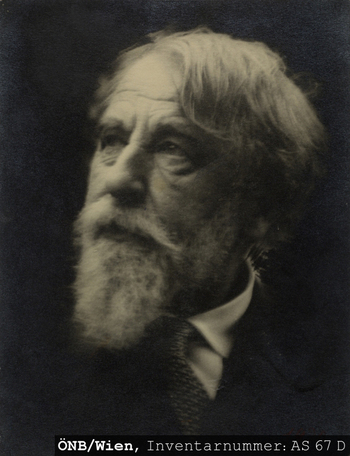 In the spring of 1930 Schnitzler’s feelings for Suzanne became stronger, while he was minded to restrict the relationship to Clara to friendship, which she however would not accept. At the end of November his health worsened significantly; and when he once more felt ill at the beginning of December, he sought a thorough examination by his long-standing doctor Ferdinand ‘Ferry’ Donath (husband of his niece Anni) at a heart clinic. The official diagnosis he was given was the same as ever, that there were no organic causes. However, Ferry confided in Clara that both he and Schnitzler’s brother, Julius, had for some time established that Schnitzler’s heart was becoming weaker and that he would not survive for much longer: ‘Only a diet, avoidance of liquids, no excitement, or that would be it’.[54] – Clara at first showed great consideration, but her resolution did not hold for long: her jealousy became almost pathological, and she began to spy on Schnitzler and monitor his post.[55] – In this year Schnitzler published his last work for the stage, In the Play of Summer Breezes (Im Spiel der Sommerlüfte).
In the spring of 1930 Schnitzler’s feelings for Suzanne became stronger, while he was minded to restrict the relationship to Clara to friendship, which she however would not accept. At the end of November his health worsened significantly; and when he once more felt ill at the beginning of December, he sought a thorough examination by his long-standing doctor Ferdinand ‘Ferry’ Donath (husband of his niece Anni) at a heart clinic. The official diagnosis he was given was the same as ever, that there were no organic causes. However, Ferry confided in Clara that both he and Schnitzler’s brother, Julius, had for some time established that Schnitzler’s heart was becoming weaker and that he would not survive for much longer: ‘Only a diet, avoidance of liquids, no excitement, or that would be it’.[54] – Clara at first showed great consideration, but her resolution did not hold for long: her jealousy became almost pathological, and she began to spy on Schnitzler and monitor his post.[55] – In this year Schnitzler published his last work for the stage, In the Play of Summer Breezes (Im Spiel der Sommerlüfte).
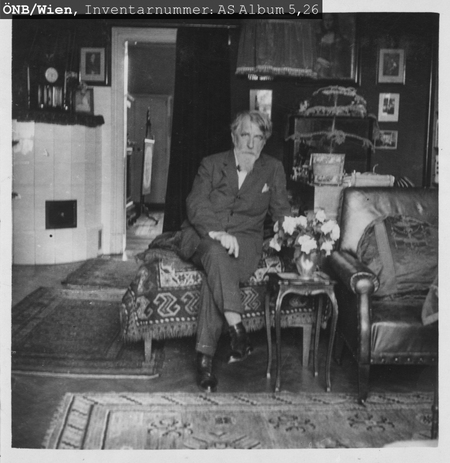 In January 1931 his condition deteriorated further. The sickness he suffered in the mornings became more intense and regular. He nonetheless participated in the early rehearsals for The Walk to the Pool at the Vienna Burgtheater. The premiere on 14 February was a great success. In the middle of March Ferry diagnosed an excess of stomach acid, which was ‘increased by the constant excitations’.[56] At the end of May he detected a marked rise in Schnitzler’s blood pressure and prescribed diuretics and medicine to strengthen his heartbeat. Schnitzler was generally feeling unwell by now, but carried on working and went out regularly. When visiting the theatre, he could now barely understand a word, on account of the otosclerosis, and there were frequent arguments with Clara.
In January 1931 his condition deteriorated further. The sickness he suffered in the mornings became more intense and regular. He nonetheless participated in the early rehearsals for The Walk to the Pool at the Vienna Burgtheater. The premiere on 14 February was a great success. In the middle of March Ferry diagnosed an excess of stomach acid, which was ‘increased by the constant excitations’.[56] At the end of May he detected a marked rise in Schnitzler’s blood pressure and prescribed diuretics and medicine to strengthen his heartbeat. Schnitzler was generally feeling unwell by now, but carried on working and went out regularly. When visiting the theatre, he could now barely understand a word, on account of the otosclerosis, and there were frequent arguments with Clara.
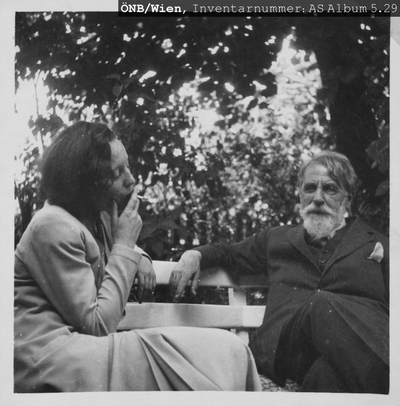 On 20 June Heinrich celebrated his debut as theatre director at the Vienna Volkstheater, with a proud Schnitzler attending the dress rehearsal and premiere. In August, the sick Schnitzler travelled to Gmunden, where he saw Olga, Heinrich and son-in-law Arnoldo for the last time. He was now suffering from intense headaches and other complaints, but he still went swimming and walking and undertook boat trips with the family. After a further major disagreement, the situation with Clara came to a head. Schnitzler went to see her in order to reach out to her once more: ‘friendship and freedom’ was his offer,[57] but Clara adamantly refused to accept: ‘she would rather kill herself’.[58] After Schnitzler left without response she took an overdose of sleeping pills. He received news of this on the same evening, but saw through her game and was not greatly concerned. – On 13 September, as every day now, Schnitzler was not well. He had an irregular heart beat and a slightly tight chest. Ferry, who was called in for an opinion two days later confirmed Schnitzler’s own diagnosis: cardiac dyspepsia (Certainly organic changes)’,[59] and then examined him regularly. Schnitzler had to interrupt his work ever more frequently because of breathing difficulties, a tight chest, heart pain and general ill-health. At the beginning of October Suzanne, who showed constant concern for Schnitzler, brought the painter Wilhelm Viktor Krausz to him, who had wanted to produce a
On 20 June Heinrich celebrated his debut as theatre director at the Vienna Volkstheater, with a proud Schnitzler attending the dress rehearsal and premiere. In August, the sick Schnitzler travelled to Gmunden, where he saw Olga, Heinrich and son-in-law Arnoldo for the last time. He was now suffering from intense headaches and other complaints, but he still went swimming and walking and undertook boat trips with the family. After a further major disagreement, the situation with Clara came to a head. Schnitzler went to see her in order to reach out to her once more: ‘friendship and freedom’ was his offer,[57] but Clara adamantly refused to accept: ‘she would rather kill herself’.[58] After Schnitzler left without response she took an overdose of sleeping pills. He received news of this on the same evening, but saw through her game and was not greatly concerned. – On 13 September, as every day now, Schnitzler was not well. He had an irregular heart beat and a slightly tight chest. Ferry, who was called in for an opinion two days later confirmed Schnitzler’s own diagnosis: cardiac dyspepsia (Certainly organic changes)’,[59] and then examined him regularly. Schnitzler had to interrupt his work ever more frequently because of breathing difficulties, a tight chest, heart pain and general ill-health. At the beginning of October Suzanne, who showed constant concern for Schnitzler, brought the painter Wilhelm Viktor Krausz to him, who had wanted to produce a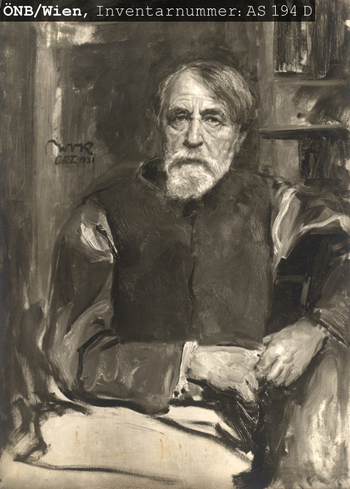 portrait of him for some time, but always meeting with his resistance. This time Schnitzler agreed and Krausz began work. In October Hedy Kempny described her impressions of Schnitzler’s state of health: ‘A. is so changed. A sick old gentleman who says little … quite unlike his usual self […] I was on the verge of tears, but I don’t want him to notice that I’m very fearful for him! He recently said to me: ‘That I have to perish in such dreadful times is almost unbearable. You will live to experience the resurgence – but for me it is the end.’ I sat with him for some time; he just lies with his hot water bottle and feels very bad’.[60] – On 19 October Schnitzler’s diary closed with the note: ‘Began reading third volume of Friedell’s Cultural History’.[61] On the following day he was in good spirits: ‘Life is fine and interesting – for the sake of the fine hours I would wish to live once more.’[62]
portrait of him for some time, but always meeting with his resistance. This time Schnitzler agreed and Krausz began work. In October Hedy Kempny described her impressions of Schnitzler’s state of health: ‘A. is so changed. A sick old gentleman who says little … quite unlike his usual self […] I was on the verge of tears, but I don’t want him to notice that I’m very fearful for him! He recently said to me: ‘That I have to perish in such dreadful times is almost unbearable. You will live to experience the resurgence – but for me it is the end.’ I sat with him for some time; he just lies with his hot water bottle and feels very bad’.[60] – On 19 October Schnitzler’s diary closed with the note: ‘Began reading third volume of Friedell’s Cultural History’.[61] On the following day he was in good spirits: ‘Life is fine and interesting – for the sake of the fine hours I would wish to live once more.’[62]
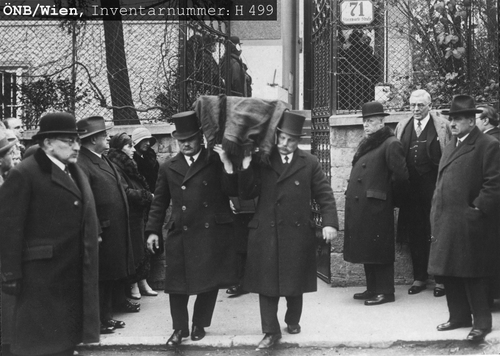 In the night of 20 October Schnitzler was then very ill. Next morning he delivered letters to the post office, returned straight home and went into his study in order to call Suzanne, but before he could reach the telephone he collapsed unconscious and died shortly afterwards from the effects of a brain haemorrhage: ‘I held his head in my hands until his last breath’.[63] – After the heart puncture that Schnitzler had ordained in his will, the body of the 69-year-old author was interred at the Vienna Central Cemetery. – In the year of his death, Flight into Darkness (Flucht in die Finsternis) and the novella collection Dream and Destiny (Traum und Schicksal) appeared.
In the night of 20 October Schnitzler was then very ill. Next morning he delivered letters to the post office, returned straight home and went into his study in order to call Suzanne, but before he could reach the telephone he collapsed unconscious and died shortly afterwards from the effects of a brain haemorrhage: ‘I held his head in my hands until his last breath’.[63] – After the heart puncture that Schnitzler had ordained in his will, the body of the 69-year-old author was interred at the Vienna Central Cemetery. – In the year of his death, Flight into Darkness (Flucht in die Finsternis) and the novella collection Dream and Destiny (Traum und Schicksal) appeared.
Schnitzler left a substantial literary estate, most of which is now kept in a number of archives,[64] and from which completed works and fragments have been posthumously published, among them some of the best known of his texts and with active reception.[65] The edition project Arthur Schnitzler digitalintends to reunite archival holdings that have been physically separated for the first time in a virtual form and so to make them more easily accessible for public purposes.
[1] Cf. Schnitzler, Arthur: Jugend in Wien. Eine Autobiographie. Ed. by Therese Nickl. Vienna etc. 1968, p. 23.
[2] Ibid., p. 32.
[3] Ibid., p. 24.
[4] Ibid., p. 40.
[5] Ibid., pp. 62–64.
[6] Ibid., p. 90.
[7] Schnitzler, Arthur: Tagebuch 1879–1931. 10 vols. Ed by. Peter Michael Braunwarth et al. for the Kommission für literarische Gebrauchsformen der Österreichischen Akademie der Wissenschaften (Director: Werner Welzig). Vienna 1987–2000. Entry of 27.10.1879.
[8] Ibid., 25.5.1880.
[9] Ibid., 2.5.1881. Cf. also A.S.: Jugend in Wien, pp. 133f.
[10] Scheible, Hartmut: Arthur Schnitzler in Selbstzeugnissen und Bilddokumenten. 13th edn. Reinbek bei Hamburg 2003, p. 40.
[11] A. S.: Tagebuch, 9.5.1886.
[12] Cf. Perlmann, Michaela: Arthur Schnitzler. Stuttgart 1987, p. 20.
[13] Nickl, Therese/Schnitzler, Heinrich (eds): Liebe, die starb vor der Zeit. Arthur Schnitzler und Olga Waissnix. Ein Briefwechsel. Vienna etc. 1970, p. 151.
[14] A.S.: Tagebuch, 13.7.1889.
[15] Cf. ibid., Nov. 1890 (p. 313).
[16] Ibid., 5.2.1891.
[17] Ibid., 9.10.1891.
[18] Ibid., 20.2.1892. Cf. also Fliedl, Konstanze (ed.): Arthur Schnitzler – Richard Beer-Hofmann. Briefwechsel 1891 – 1931. Vienna, Zurich 1992. pp. 34f.
[19] A.S.: Tagebuch, 20.4.1893.
[20] Cf. i.a. ibid., 20.9.1892 and Scheible (2003), pp. 47, 50.
[21] A.S.: Tagebuch, 23.3.1895.
[22] Cf. Podewski, Madleen: Schnitzler und der Buch- und Zeitschriftenmarkt seiner Zeit. In: C. Jürgensen/ W. Lukas/ M. Scheffel (eds): Schnitzler Handbuch. Leben – Werk – Wirkung. Stuttgart, Weimar 2014, pp. 52–56 (p. 55).
[23] Scheible (2003), p. 57.
[24] Cf. i.a. Schnitzler, Olga: Spiegelbild der Freundschaft. Salzburg 1962, p. 140.
[25] Cf. e.g. A.S.: Tagebuch, 30.7.1897.
[26] Ibid., 30.9.1897.
[27] Nickl, Therese / Schnitzler, Heinrich (eds): Hugo von Hofmannsthal – Arthur Schnitzler. Briefwechsel. Frankfurt/Main 1964, pp. 119f. Cf. also Bergel, Kurt (ed.): Georg Brandes und Arthur Schnitzler. Ein Briefwechsel. Berne 1956, p. 75.
[28] Cf. O. Schnitzler (1962), pp. 24–27.
[29] A.S. Tagebuch, 19.7.1900.
[30] Ibid., 10.5.1901.
[31] Cf. O. Schnitzler (1962), p. 107; A.S.: Tagebuch, 21.6.1901; and N.N.: Wien, 20 Juni. In: Neue Freie Presse, 21.6.1901.
[32] A.S.: Tagebuch, 9.8.1902; i.e. Der Weg ins Freie.
[33] See the diary references to the ‘Tchl.’ apartment. In the list of corrigenda (‘changes during printing and corrections’) of the 1900 edition of the Vienna Address Book, Lehmann’s Allgemeiner Wohnungs-Anzeiger, the entry ‘Schnitzler Arthur, MDr., IX. Frankg. 1’ is corrected to ‘Schnitzler, Arthur, MDr., s[ince] Dec[ember]: a[lso] writer, I. Tuchlauben 22.” This change was however clearly not prompted by Schnitzler, for he writes in his diary on 16.1.1900: ‘My Tchl. Apartment is in Lehmann; was exceptionally irritated.’ and then again a day later: ‘Continuing irritation over this stupidity.’ (A.S.: Tagebuch, 17.1.1900). The landlord of the apartment in 22 Tuchaluben was the merchant Leopold Simon, who was evidently not all too careful with this information. Schnitzler immediately terminated the tenancy; cf. the diary entry of 30.1.1900: ‘Met Joh. Fr.; she told me that Simon had said at a party that I hold rendez-vous with a lady in his house (I had just terminated).’ – See also Schnitzler, Arthur: Träume. Das Traumtagebuch. 1875–1931. Ed. by Peter Michael Braunwarth and Leo. A. Lensing. Göttingen 2012, p. 280.
[34] Cf. also O. Schnitzler (1962), p. 100.
[35] Braunwarth, Peter M. et al. (eds): Arthur Schnitzler. Briefe 1913–1931. Frankfurt/Main 1984, pp. 35f.
[36] Urbach, Reinhard: Arthur Schnitzler. In: Österreichische Akademie der Wissenschaften (ed.): Österreichisches biographisches Lexikon 1815–1950. Vol. 10. Vienna 1994, pp. 407–409 (p. 408).
[37] A.S.: Tagebuch, 5.8.1914.
[38] Cf. also Farese, Giuseppe: Arthur Schnitzler. Ein Leben in Wien. 1862–1931. Trans. by Karin Krieger. Munich 1999, p. 189.
[39] A.S.: Tagebuch, 12.11.1918.
[40] Farese (1999), p. 209.
[41] Cf. A.S.: Tagebuch, 18.11.1921.
[42] Schnitzler, Heinrich (ed.): Sigmund Freud. Briefe an Arthur Schnitzler. In Neue Rundschau 66, 95–106 (p. 97).
[43] A.S.: Briefe 1913–1931, p. 279.
[44] A.S.: Tagebuch, 14.2.1923.
[45] Farese (1999), p. 246.
[46] Cf. A.S.: Tagebuch, 17.5.1923.
[47] Ibid., 6.3.1927.
[48] Ibid., 27.4.1927.
[49] Ibid., 30.6.1927.
[50] Ibid.
[51] Ibid., 15.9.1927.
[52] Ibid., 14.6.1928.
[53] A.S. Briefe 1913–1931, p. 562f.
[54] Pollaczek, Clara Katharina: Arthur Schnitzler und ich. 3 vols. Unpublished typescript in the Manuscript Department of the Wienbibliothek (classmark: LQH0167828). Vol. 3, p. 136, quoted from Weinzierl, Ulrich: Arthur Schnitzler. Lieben, Träumen, Sterben. Frankfurt/Main 1994, p. 216.
[55] Cf. Farese (1999), p. 326.
[56] A.S.: Tagebuch, 17.3.1931.
[57] Ibid., 26.8.1931.
[58] Ibid.
[59] Ibid., 15.9.1931.
[60] Adamek, Heinz P. (ed.): Hedy Kempny/Arthur Schnitzler. ‘Das Mädchen mit den dreizehn Seelen’. Eine Korrespondenz ergänzt durch Blätter aus Hedy Kempnys Tagebuch sowie durch eine Auswahl ihrer Erzählungen. Reinbek bei Hamburg 1984, p. 361.
[61] A.S.: Tagebuch, 19.10.1931.
[62] Pollaczek [n.d.] III, p. 253, quoted in Weinzierl (1994), p. 217.
[63] Pollaczek [n.d.] III, p. 253, quoted in Wagner, Renate: Arthur Schnitzler. Eine Biographie. Vienna etc. 1981, p. 386.
[64] Cf. Hemecker, Wilhelm / Österle, David: ,… so grundfalsch war alles Weitere‘. Zur Geschichte des Nachlasses von Arthur Schnitzler. In: Jahrbuch der Deutschen Schillergesellschaft 58 (2014), pp. 3–40.
[65] For instance, The Second (Der Sekundant), Adventurer’s Novella (Abenteurernovelle), Novellette [i.e. I (Ich)] and most recently Late Fame (Später Ruhm) [i.e. Story of the Aged Writer (Geschichte vom greisen Dichter)]. See the list of posthumous individual publications from the literary estate in: Fink, Kristina: Auswahlbibliographie. In: C. Jürgensen, W. Lukas, M. Scheffel (2014), pp. 415–428 (p. 420).
Bibliography ⇑
Adamek, Heinz P. (ed.): Hedy Kempny / Arthur Schnitzler. ,Das Mädchen mit den dreizehn Seelen‘. Eine Korrespondenz ergänzt durch Blätter aus Hedy Kempnys Tagebuch sowie durch eine Auswahl ihrer Erzählungen. Reinbek bei Hamburg 1984.
Arnold, Heinz Ludwig (ed.): Arthur Schnitzler. Munich 1998.
Bergel, Kurt (ed.): Georg Brandes und Arthur Schnitzler. Ein Briefwechsel. Berne 1956.
Braunwarth, Peter M. et al. (ed.): Arthur Schnitzler. Briefe 1913–1931. Frankfurt/Main 1984.
Farese, Guiseppe: Arthur Schnitzler. Ein Leben in Wien. 1862–1931. Trans. by Karin Krieger. Munich 1999.
Fink, Kristina: Auswahlbibliographie. In: C. Jürgensen, W. Lukas, M. Scheffel (eds): Schnitzler Handbuch. Leben – Werk – Wirkung. Stuttgart, Weimar 2014, pp. 415–428.
Fliedl, Konstanze: Arthur Schnitzler. Stuttgart 2005.
Fliedl, Konstanze (ed.): Arthur Schnitzler – Richard Beer-Hofmann. Briefwechsel 1891–1931. Vienna, Zurich 1992.
Hemecker, Wilhelm / Österle, David: , ,… so grundfalsch war alles Weitere‘. Zur Geschichte des Nachlasses von Arthur Schnitzler. In: Jahrbuch der Deutschen Schillergesellschaft 58 (2014), pp. 3–40.
Kapp, Julius: Arthur Schnitzler. Leipzig 1912.
Lindgren, Irène: Arthur Schnitzler im Lichte seiner Briefe und Tagebücher. Heidelberg 1993.
Majer, Eduard H.: Johann Schnitzler. In: Österreichische Akademie der Wissenschaften (ed.): Österreichisches biographisches Lexikon 1815–1950. Vol. 10. Vienna 1994, pp. 410–411.
N. N.: Wien, 20. Juni. In: Neue Freie Presse, 21.6.1901.
Nickl, Therese / Schnitzler, Heinrich (eds): Hugo von Hofmannsthal – Arthur Schnitzler. Briefwechsel. Frankfurt/Main 1964.
Nickl, Therese / Schnitzler, Heinrich (eds): Liebe, die starb vor der Zeit. Arthur Schnitzler und Olga Waissnix. Ein Briefwechsel. Vienna etc. 1970.
Perlmann, Michaela: Arthur Schnitzler. Stuttgart 1987.
Podewski, Madleen: Schnitzler und der Buch- und Zeitschriftenmarkt seiner Zeit. In: C. Jürgensen, W. Lukas, M. Scheffel (eds): Schnitzler Handbuch. Leben – Werk – Wirkung. Stuttgart, Weimar 2014, pp. 52–56.
Pollaczek, Clara Katharina: Arthur Schnitzler und ich. 3 vols. Unpublished typescript in the Manuscript Department of the Wienbibliothek (classmark: LQH0167828).
Scheffel Michael: Arthur Schnitzler. Erzählungen und Romane. Berlin 2015.
Scheible, Hartmut: Arthur Schnitzler in Selbstzeugnissen und Bilddokumenten. 13th edn. Reinbek bei Hamburg 2003.
Schnitzler, Arthur: Jugend in Wien. Eine Autobiographie. Ed. by Therese Nickl. Vienna etc. 1968.
Schnitzler, Arthur: Tagebuch 1879–1931. 10 vols. Ed by. Peter Michael Braunwarth et al. for the Kommission für literarische Gebrauchsformen der Österreichischen Akademie der Wissenschaften (Director: Werner Welzig). Vienna 1987–2000.
Schnitzler, Heinrich (ed.): Sigmund Freud. Briefe an Arthur Schnitzler. In: Neue Rundschau 66 (1955), pp. 95–106.
Schnitzler, Heinrich / Brandstätter, Christian / Urbach, Reinhard (eds): Arthur Schnitzler. Sein Leben. Sein Werk. Seine Zeit. Frankfurt/Main 1981.
Schnitzler, Olga: Spiegelbild der Freundschaft. Salzburg 1962.
Specht, Richard: Arthur Schnitzler und sein Werk. Eine Studie. Berlin 1922.
Urbach, Reinhard: Arthur Schnitzler. In: Österreichische Akademie der Wissenschaften (ed.): Österreichisches biographisches Lexikon 1815–1950. Vol. 10. Vienna 1994, pp. 407–409.
Wagner Renate: Arthur Schnitzler. Eine Biographie. Vienna etc. 1981.
Weinzierl, Ulrich: Arthur Schnitzler. Lieben, Träumen, Sterben. Frankfurt/Main 1994.



